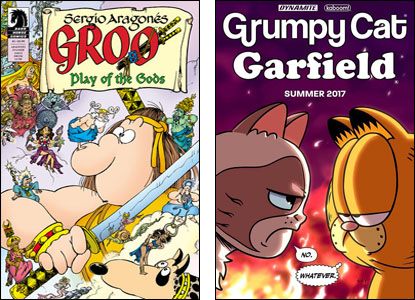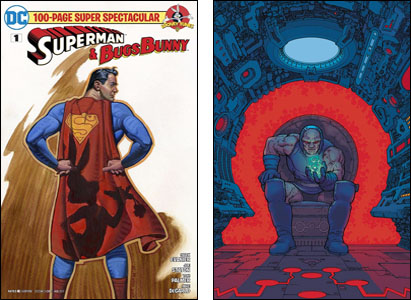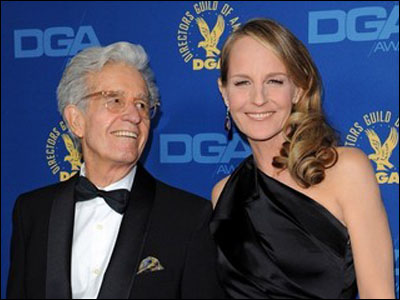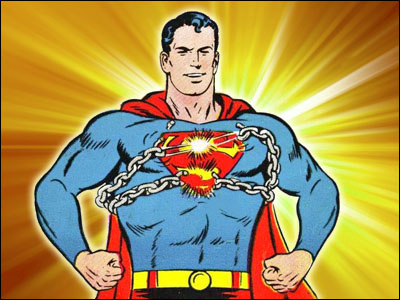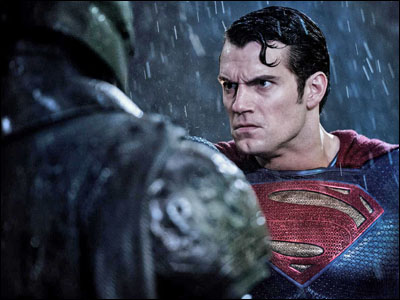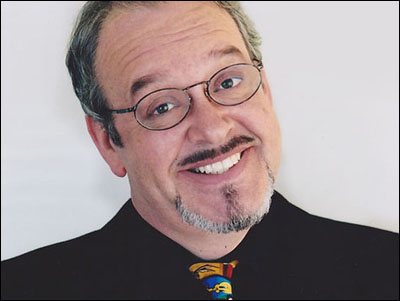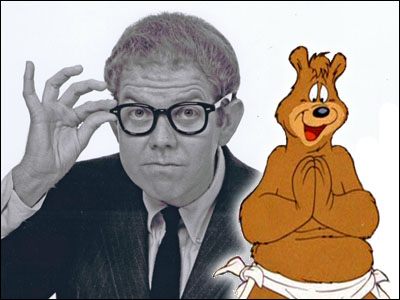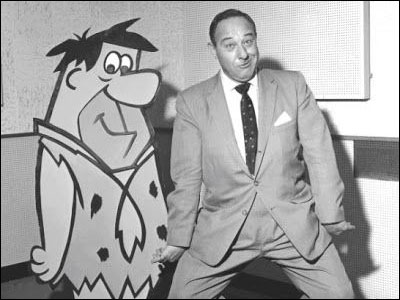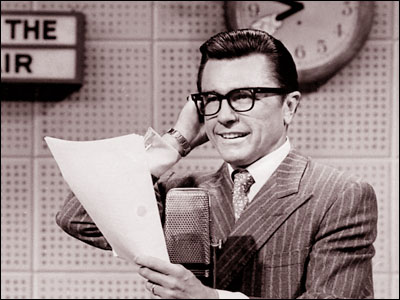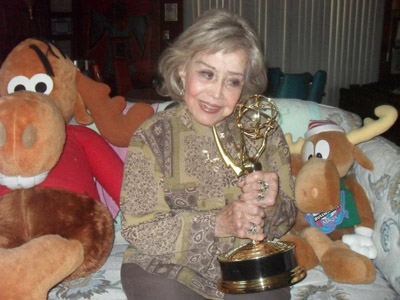
June Foray died this morning, just 54 days shy of what would have been her 100th birthday. This was not unexpected. I saw her just six weeks ago and she was very small and very frail and just about ready to go. Her sister had died not long before and her brother-in-law died shortly after that visit.
She was, of course, the premier female voice talent of her era. I don't know who the runner-up was but whoever it was, she was in a distant second in terms of hours logged voicing cartoons and commercials, dubbing movies, doing narration, appearing on radio shows and records…even providing the voice for talking dolls. A few years ago when Earl Kress and I assisted her with her autobiography, we foolishly thought we could whip up a near-complete list of everything she'd done. Not in this world possible. I know more of June's credits than most people and I'd be surprised if I know 10% of it.
She was Rocky the Flying Squirrel. She was Natasha Fatale. She was Nell Fenwick. She was Jokey Smurf. She was Cindy Lou Who. She was Granny, owner of Tweety. She was Witch Hazel. She was Chatty Cathy. She was thousands of others.

Most of all, she was June Foray, a talented workaholic who for decades, drove into Hollywood every weekday early in the morning and went from recording session to recording session until well after dark. Everyone hired her because she was always on time, always professional and what she did was always good. It was her good friend, director Chuck Jones who said, "June Foray is not the female Mel Blanc. Mel Blanc is the male June Foray."
June Foray was born in Springfield, Massachusetts on September 18, 1917. The talent she exhibited at an early age was encouraged by her parents and by age 12, she was appearing on local radio dramas playing children's parts. By 15, she was working steadily on a wide array of series and was playing roles that were often older — much older than she was.
When she finally graduated high school, her family moved to Los Angeles, California so that June could break into national radio, which she did in no time. A short list of the programs on which she was heard would include The Cavalcade of America, A Date With Judy, Sherlock Holmes (with Basil Rathbone and Nigel Bruce), Mayor of the Town (with Lionel Barrymore), The Whistler, The Billie Burke Show, The Rudy Vallee Show, Stars Over Hollywood, The Al Pearce Show, This is My Best (with Orson Welles), Kay Kyser's Kollege of Musical Knowledge, Baby Snooks (with Fanny Brice), Dr. Christian (with Jean Hersholt), I Deal in Crime (with Bill Gargan), Jack Haley's Sealtest Village Store, Glamour Manor (with Kenny Baker), Phone Again Finnegan (with Stu Erwin), The Charlie McCarthy Show (with Edgar Bergen), The Dick Haymes Show, Fibber McGee and Molly, The Bob Hope Show, The Penny Singleton Show, Presenting Charles Boyer, Tex Williams's All-Star Western Theater, Red Ryder, The Screen Directors' Playhouse, The Screen Guild Theatre, The Lux Radio Theater, The Great Gildersleeve, My Favorite Husband (with Lucille Ball), Richard Diamond: Private Detective (with Dick Powell), and Martin Kane, Private Eye. She was a regular on the popular comedy series, Smile Time, which introduced her longtime friend Steve Allen to much of America.
When television came along, June was there with roles on Johnny Carson's first TV series, Carson's Cellar, and dozens of other programs including Andy's Gang, where she worked with the man she'd soon marry, Hobart Donavan. They were married until his death in 1976.
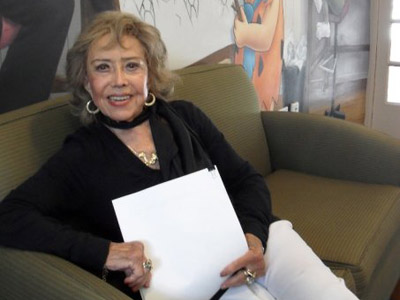
Experts disagree as to when June did her first animation work. She usually cites the role of the cat Lucifer in Disney's Cinderella (1950) and she did much work for Mr. Disney, both in front of the microphone and also posing occasionally as a model to aid the animators. In 1955, she began voicing dozens of characters for Warner Brothers cartoons and then in 1959 came Rocky and His Friends, the show on which she first played Rocky the Flying Squirrel. In fact, she not only voiced the plucky squirrel but most of the female (and even a few male) voices for the many cartoon shows produced by Jay Ward.
June was in fact heard in the cartoons of every major animation producer located on the West Coast for years, including MGM, UPA, Walter Lantz and Hanna-Barbera. She continued to work in animation well into her nineties and in 2012 won her first Emmy Award for her role as Mrs. Cauldron, a witch seen around the world on The Garfield Show. Some claim that victory made her the oldest performer to ever win an Emmy. She was later awarded an honorary one.
Her voice was also heard on hundreds of live-action TV shows, including Baretta, The Girl From U.N.C.L.E., Green Acres and The Twilight Zone. For the latter, she was the voice of "Talky Tina" in a memorable episode that called for June to play the evil side of the popular talking doll she voiced for Mattel Toys, Chatty Cathy. She has been heard (but not seen) in dozens of motion pictures including Jaws, Bells Are Ringing, The Hospital and The Comic.
June was active in the film community, having founded the Los Angeles chapter of Association Internationale du Film d'Animation (the International Animated Film Association) and serving multiple terms on the Board of Governors of the Academy of Motion Picture Arts and Sciences. She was also a wonderful lady and someone I loved dearly. A lot of us are going to spend the rest of our lives bragging unashamedly that we got to know and/or work with June Foray.
